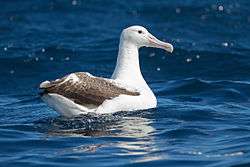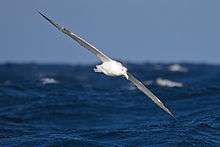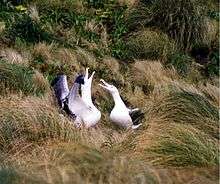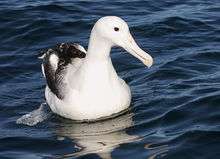Southern royal albatross
| Southern royal albatross | |
|---|---|
 | |
| East of Tasmania | |
| Scientific classification | |
| Kingdom: | Animalia |
| Phylum: | Chordata |
| Class: | Aves |
| Order: | Procellariiformes |
| Family: | Diomedeidae |
| Genus: | Diomedea |
| Species: | D. epomophora |
| Binomial name | |
| Diomedea epomophora (Forster, 1785) | |
| Synonyms | |
|
Diomedea epomophora epomophora | |
The southern royal albatross (Diomedea epomophora) is a large seabird from the albatross family. At an average wingspan of above 3 m (9.8 ft), it is one of the two largest species of albatross, together with the wandering albatross. Recent studies indicate that the southern royal albatross may, on average, be somewhat larger than the wandering albatross in mass and wingspan,[2] although other sources indicate roughly similar size for the two species.[3]
Taxonomy
Albatrosses belong to Diomedeidae family and come from the Procellariiformes order, along with shearwaters, fulmars, storm petrels, and diving petrels. They share certain identifying features. First, they have nasal passages that attach to the upper bill called naricorns; the nostrils of the albatross are on the sides of the bill. The bills of Procellariiformes are also unique in that they are split into between seven and nine horny plates. Finally, they produce a stomach oil made up of wax esters and triglycerides that is stored in the proventriculus. This is used against predators as well as an energy rich food source for chicks and for the adults during their long flights.[4] It was once considered conspecific with the northern royal albatross (Diomedea sanfordi) as the royal albatross and the split into two species is almost universally accepted, for example by, BirdLife International,[5] Brooke,[6] and Robertson & Nunn.[7] Clements still does not recognize the split,[8] and the SACC has recognized the need for a proposal.[9]
Etymology


Diomedea epomophora breaks into Diomedea referring to Diomedes, whose companions turned to birds.[10]
Description
The southern royal albatross has a length of 112 to 123 cm (44–48 in)[11] and a mean weight of 8.5 kg (19 lb). At Campbell Island, 11 males were found to have a mean mass of 10.3 kg (23 lb) and 7 females were found to have a mean mass of 7.7 kg (17 lb), thus may be heavier on average than most colonies of wandering albatross.[3] Males are about 2 to 3 kg (4.4 to 6.6 lb) heavier than females. Average wingspan has been reported from 2.9 to 3.28 m (9.5 to 10.8 ft), with an upper limit of about 3.51 m (11.5 ft). The wandering albatross can exceed this species in maximum size and averages slightly larger in linear dimensions if not bulk, but the two species are close enough in dimensions that size cannot be used to distinguish between them.[12][13][14] The juvenile has a white head, neck, upper mantle, rump, and underparts. There are black speckles on the mantle, and they have dark brown or black wings with white flecks on coverts. Their tail is white except for the black tip as is the under-wing. Young birds soon lose the black on their tail and backs. White appears on the upperwing gradually, as speckles starting from the leading edge. All ages have a pink bill with black on the cutting edge on the upper mandible, and the legs are flesh. Young birds with all dark upperwings can be hard to differentiate from the northern royal albatross. There are clear but subtle differences compared to the wandering albatross, with the southern having a clean black and white appearance, lacking the peach neck spot often found on the wandering albatross. Most wandering albatrosses have dark feathers in the tail and crown and the white in this species expands from the middle of the wing, in larger blotches. The bill color is also slightly paler, as well as the dark cutting edge along the middle. The average life span is 58 years.[15]
Range
| Location | Population | Date | Trend |
|---|---|---|---|
| Campbell Islands | 8,200-8,600 pair | 1997 | Stable |
| Enderby Island | 69 pair | 2001 | Stable |
| Auckland Island & Adams Island | 20 pair | 2001 | Stable |
| Total | 28,000-29,500 | 1997 | Stable |
Most of the royal albatross population is found between 30°s and 45°s.[16] The majority of the world's population of southern royal albatrosses nest on the rat free Subantarctic Campbell Island, around 8,200 to 8,600 pairs. There are smaller colonies on Adams Island and Auckland Island in the Auckland Islands, 20 pairs combined, and 69 pairs on Enderby Island and some sanfordi X epomophora hybrids at the northern royal albatross colony on the Otago Peninsula in New Zealand. They range along the southern oceans concentrating on the west and east coast of southern South America, and also in the waters surrounding New Zealand.[11]
Behavior
Feeding
The southern royal albatross eats squid and fish, with smaller amounts of carrion, crustaceans, and salps.[11] Its foraging activities normally take place within a 1250 km radius of their breeding site.[17]
Reproduction

They prefer to nest on tussock grassland, plateaus, or ridges, and will lay one egg biennially. This will normally take place in November or December. Both parents will incubate the egg, and rear the young. There is very low mortality rates of the laid eggs once the parents settle in.[18] When feeding the young they will range south to the Campbell Plateau and north to the Chatham Rise.[11]
Conservation
The IUCN classifies this bird as vulnerable,[1] with an occurrence range of 63,400,000 km2 (24,500,000 sq mi) and a breeding range of 750 km2 (290 sq mi), with a total estimated population of between 28,000 and 29,500 (1997). As a top-tier organism in its natural habitat, it has very few predators but major fishing industries are a huge problem for all albatross species among other seabirds.[19]
The population is recovering from its severe downward spiral in the late 19th and early 20th centuries. By the 1880s, this albatross was extirpated from Auckland Island and Enderby Island. Pigs and cats are still a problem, as they take chicks and eggs, on Auckland Island. Longline fishing is a major problem and a possible emerging threat is Dracophyllum, a scrub that is taking away from their nesting range.[11]
Gallery
_with_chick_on_Campbell_Island.jpg) Adult with chick on mound nest on Campbell Island
Adult with chick on mound nest on Campbell Island.jpg) Southern Ocean, New Zealand
Southern Ocean, New Zealand Southern Ocean, New Zealand
Southern Ocean, New Zealand Pair on Campbell Island
Pair on Campbell Island Off Kaikoura, New Zealand
Off Kaikoura, New Zealand
Footnotes
- 1 2 BirdLife International (2012). "Diomedea epomophora". IUCN Red List of Threatened Species. Version 2013.2. International Union for Conservation of Nature. Retrieved 26 November 2013.
- ↑ Albatross, their world, their ways. De Roy, Jones and Fitter, 2008. Firefly Press
- 1 2 CRC Handbook of Avian Body Masses, 2nd Edition by John B. Dunning Jr. (Editor). CRC Press (2008), ISBN 978-1-4200-6444-5.
- ↑ Double, M. C. (2003)
- ↑ Lee, James (2008)
- ↑ Brooke, R. (2004)
- ↑ Robertson, C. J. R. & Nunn, G. B. (1998)
- ↑ Clements, J. (2007)
- ↑ Remsen Jr., C. J. (2008)
- ↑ Gotch, A. F. (1995)
- 1 2 3 4 5 6 BirdLife International (2008)
- ↑ Brooke, Michael, Albatrosses and Petrels across the World. Oxford University Press (2004), ISBN 978-0-19-850125-1
- ↑ Wood, Gerald (1983). The Guinness Book of Animal Facts and Feats. ISBN 978-0-85112-235-9.
- ↑ Harrison, Peter, Seabirds: An Identification Guide. Houghton Mifflin Harcourt (1991), ISBN 978-0-395-60291-1
- ↑ LaGosh, J. (2004). Diomedea epomophora. Retrieved from http://animaldiversity.ummz.umich.edu/site/accounts/information/Diomedea_epomophora.html
- ↑ Robertson, C. J. R., & Kinsky, F. C. (1972). The dispersal movements of the royal albatross (Diomedea epomophora). Notornis, 19(4), 289-301.
- ↑ Waugh, S., Troup, C., Filippi, D., & Weimerskirch, H. (2002). Foraging zones of Southern Royal albatrosses. The Condor, 104(3), 662-667.
- ↑ Dilks, P. J., & Wilson, P. R. (1979). Feral sheep and cattle and royal albatrosses on Campbell Island; population trends and habitat changes. New Zealand Journal of Zoology, 6(1), 127-139.
- ↑ Sullivan, B. J., Reid, T. A., & Bugoni, L. (2006). Seabird mortality on factory trawlers in the Falkland Islands and beyond. Biological Conservation, 131(4), 495–504.
References
- BirdLife International (2008). "Bartlett's Tinamou - BirdLife Species Factsheet". Data Zone. Retrieved 18 Feb 2009.
- Brands, Sheila (Aug 14, 2008). "Systema Naturae 2000 / Classification - Diomedea (Diomedea) epomophora -". Project: The Taxonomicon. Retrieved 18 Feb 2009.
- Brooke, M. (2004). "Procellariidae". Albatrosses And Petrels Across The World. Oxford, UK: Oxford University Press. ISBN 0-19-850125-0.
- Clements, James (2007). The Clements Checklist of the Birds of the World (6th ed.). Ithaca, NY: Cornell University Press. ISBN 978-0-8014-4501-9.
- Double, M. C. (2003). "Procellariiformes (Tubenosed Seabirds)". In Hutchins, Michael; Jackson, Jerome A.; Bock, Walter J.; Olendorf, Donna. Grzimek's Animal Life Encyclopedia. 8 Birds I Tinamous and Ratites to Hoatzins. Joseph E. Trumpey, Chief Scientific Illustrator (2nd ed.). Farmington Hills, MI: Gale Group. pp. 107–111. ISBN 0-7876-5784-0.
- Gotch, A. F. (1995) [1979]. "Albatrosses, Fulmars, Shearwaters, and Petrels". Latin Names Explained A Guide to the Scientific Classifications of Reptiles, Birds & Mammals. New York, NY: Facts on File. p. 190. ISBN 0-8160-3377-3.
- Lee, James (6 Oct 2008). "Table 7: Species changing IUCN Red List Status" (PDF). IUCN RedList. BirdLife International. Archived from the original (PDF) on March 6, 2009. Retrieved 18 Feb 2009.
- Remsen Jr., J. V.; et al. (7 Aug 2008). "A classification of the bird species of South America, South American Classification Committee, American Ornithologists' Union". South American Classification Committee. American Ornithologists' Union. Retrieved 18 Feb 2009.
- Robertson, C. J. R.; Nunn, G. B. (1998). "Towards a new taxonomy of albatrosses". Albatross Biology and Conservation. Chipping Norton, Australia: Surrey Beatty & Sons Ltd. pp. 13–19.
External links
| Wikimedia Commons has media related to Diomedea epomophora. |
- Photos - Christopher Taylor Nature Photography
- Species factsheet - BirdLife International
- Photos and fact file - ARKive
